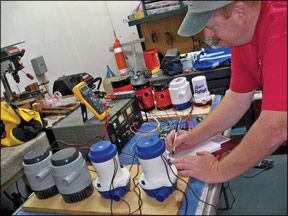This months bilge pump test brought back long-suppressed memories from a passage my wife and I made in the western Pacific years ago. It is a testimony to our marriage that we can laugh about it now.

The rhumb line route from Rabaul, New Britain, to Guam is about 1,300 miles. Most of the year, the passage leads you through the doldrums, then puts you hard on a starboard tack, clawing against the prevailing northeasterlies, then creeping northwest through typhoon alley. If youre in a heavily laden, gaff-rigged boat that tacks through 116 degrees and close reaches at the breakneck speed of 4.6 knots, it seems more like 10,000 miles.
We left in March, when the chance of tropical storm development was theoretically low. A few days of calm let us slingshot east on the equatorial counter-current, giving us a wider wind angle when we turned north.
Once the trades filled in, the long, wet, trying beat to Guam took hold. Thirteen days fighting to windward in an old wooden boat has few positives, but this months electric bilge pump test (page 24) reminded me of one: You earn a whole new appreciation for those whirring wizards beneath the floorboards.
About 200 miles north of the equator, I was awakened by splashing in the bilge. Lifting the floorboards and peering into the darkness below with a flashlight, my worries were confirmed: the boat was leaking and the Rule Mate 2000 bilge pump was kaput. More poking around revealed a long topside seam that had opened up.
When it comes to eliminating the slosh, slosh that keeps us awake at night, choosing the right pump is half the battle. The art of pump installation is equally critical. With the hopes of sparing someone else a long painful night on his belly, fiddling with pumps and wires in a dark bilge, I offer these tips:
Have at least one backup electric bilge pump installed and working. Keep a third electric pump for a spare when the first fails.
Inspect and test your electric bilge pump weekly at anchor, before each passage, and daily while underway.
Minimize head pressure
(resistance in the hoses) by using smooth bore hose that doesn’t kink. Eliminate 90-degree elbow fittings or sharp bends.
Loop your outlet hose well above the waterline when the boat is heeled so that seawater cannot siphon back on board.
Keep your bilge clean and free of chemicals, oil, hair, bottle caps, toothpicks, and Lego blocks.
Make sure wire gauges are big enough to minimize any voltage drop, connections are watertight, and you have the correctly sized fuses for your pump.
Finally, the best electric bilge pump is no substitute for a good manual model. For the rest of that long, wet, beat, few sounds were as soothing as the deep slurp of our dual-action
Edson 30-GPM diaphragm pump.




































